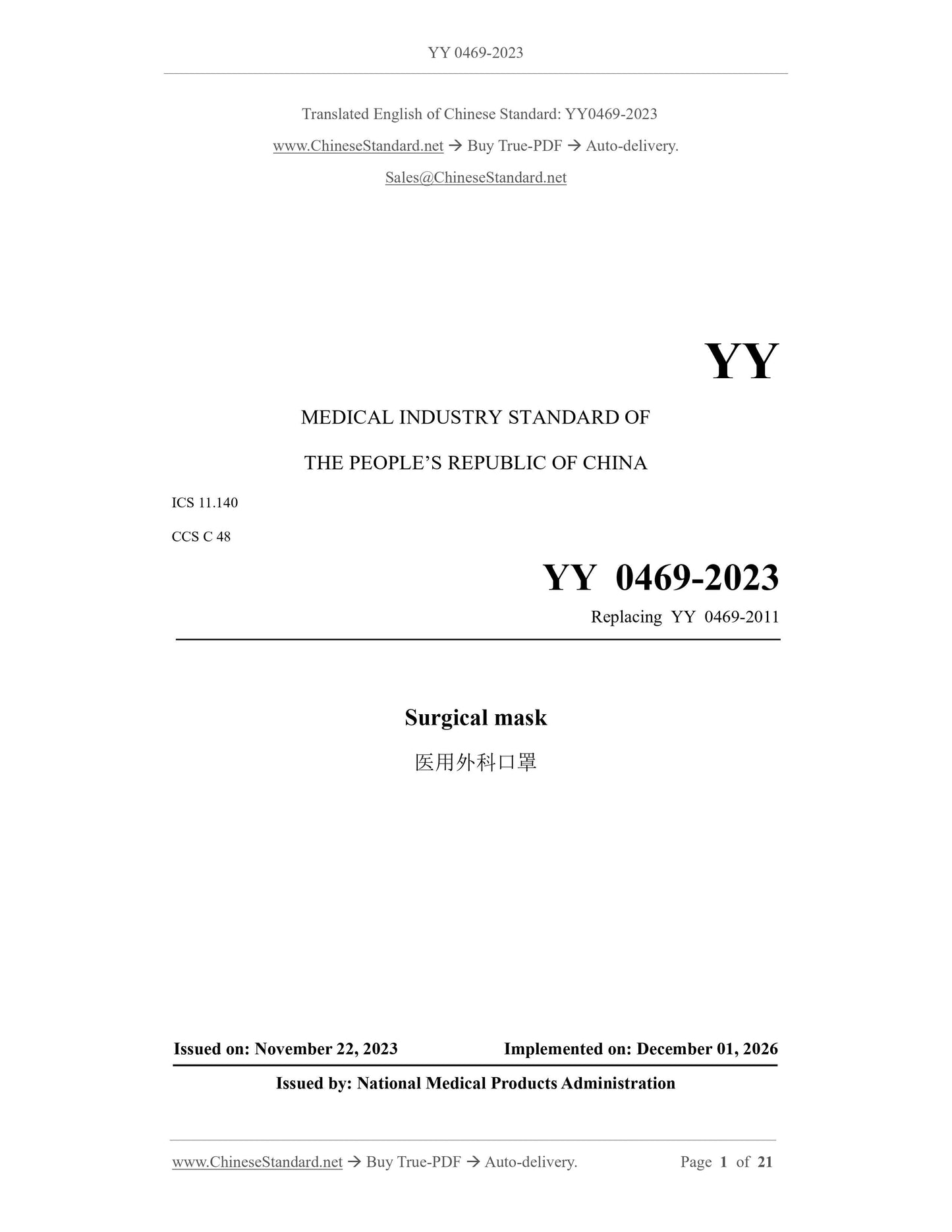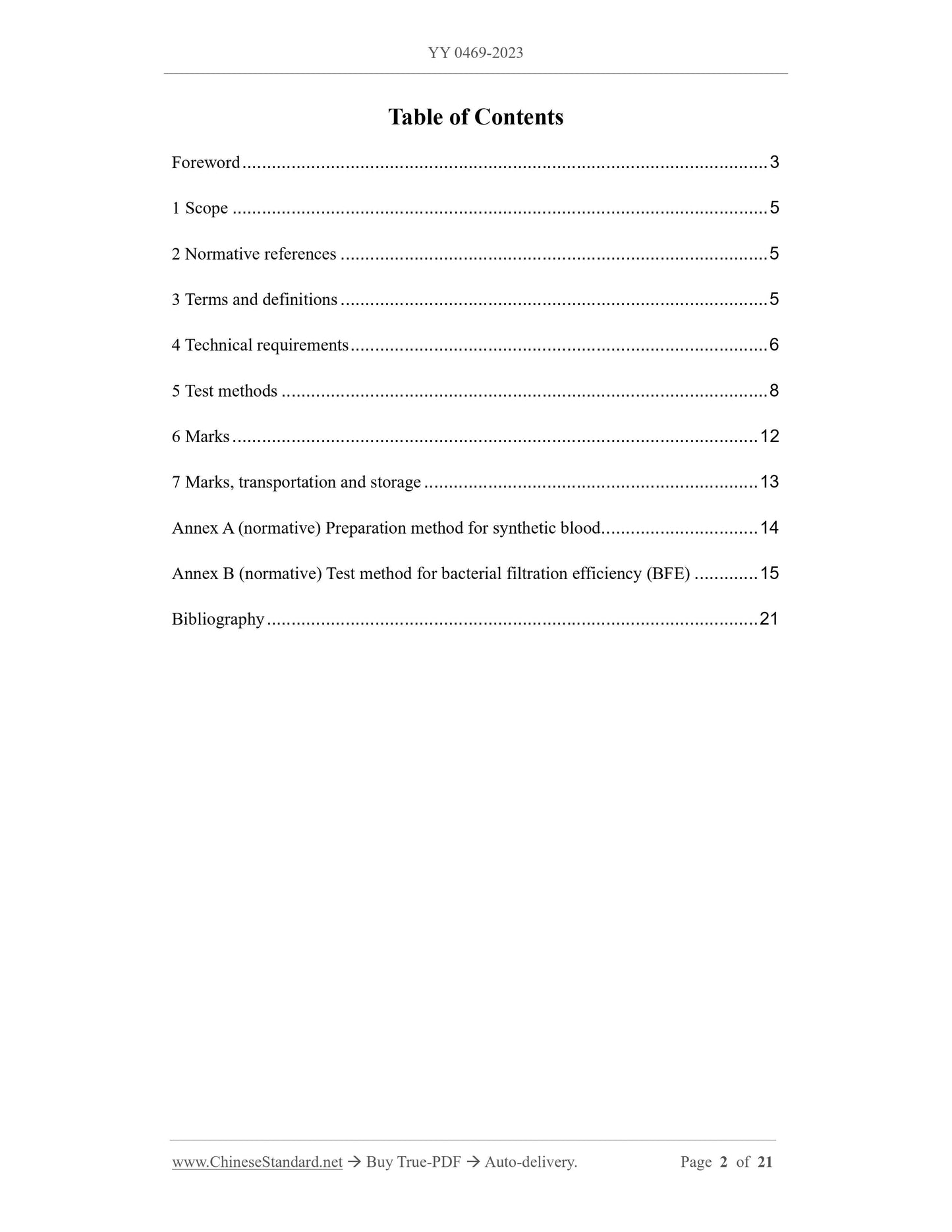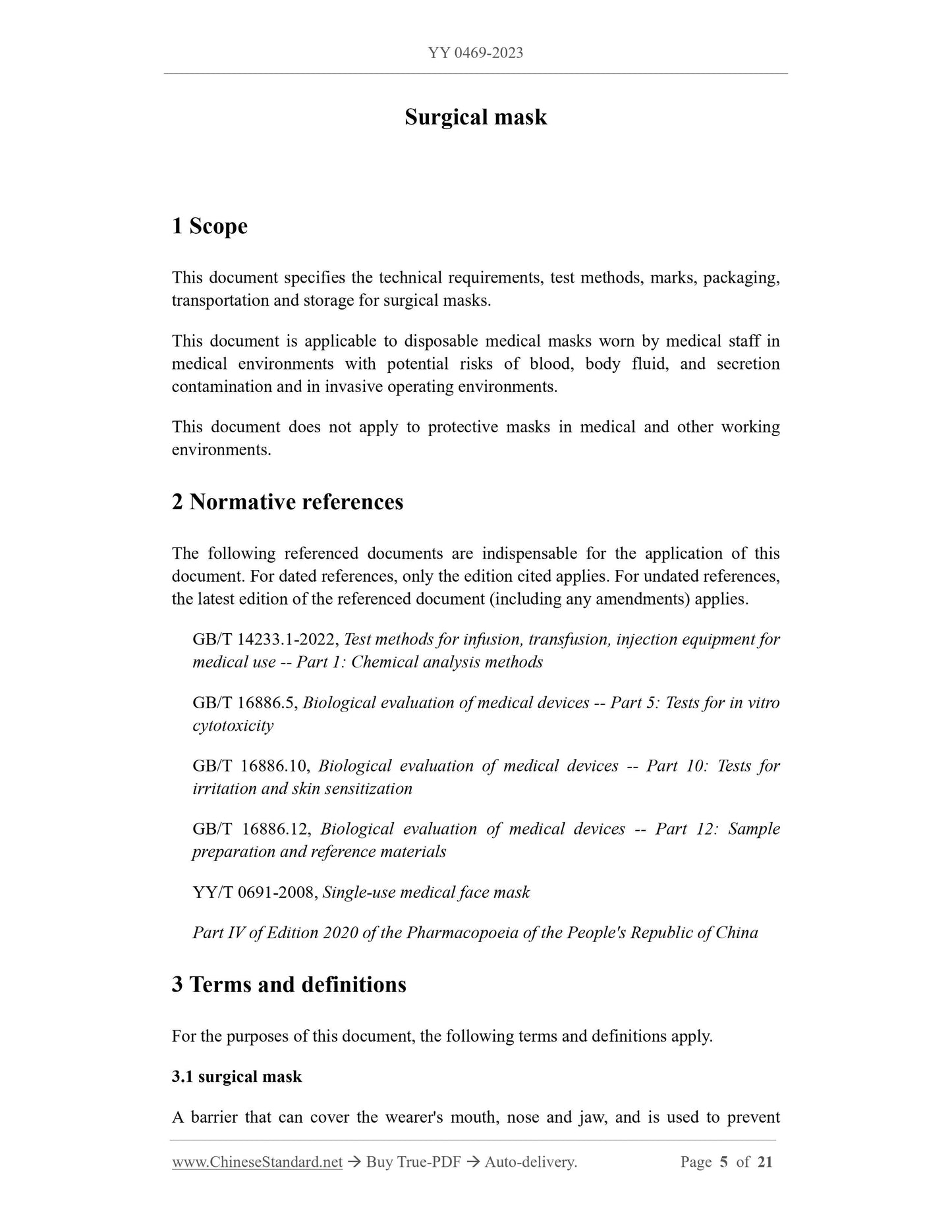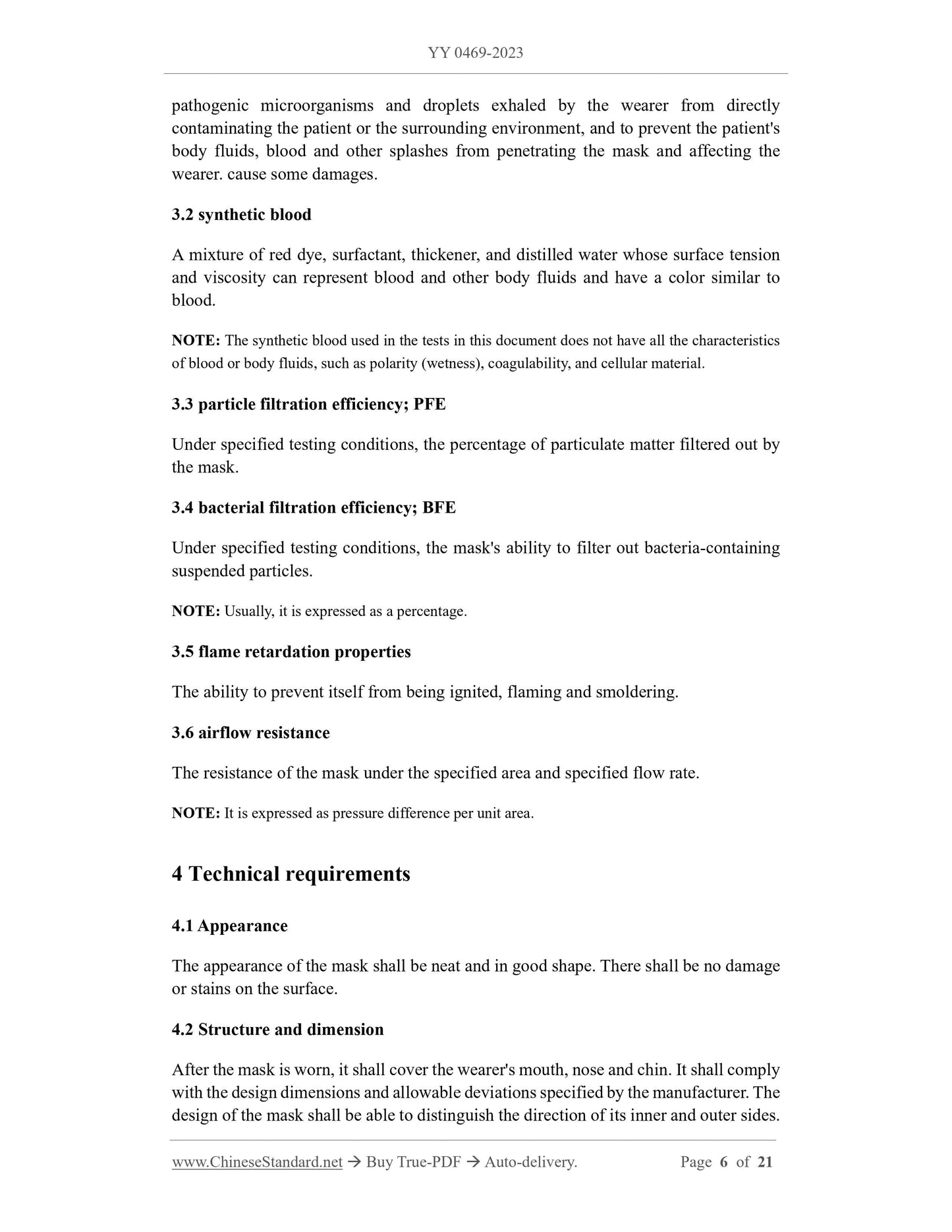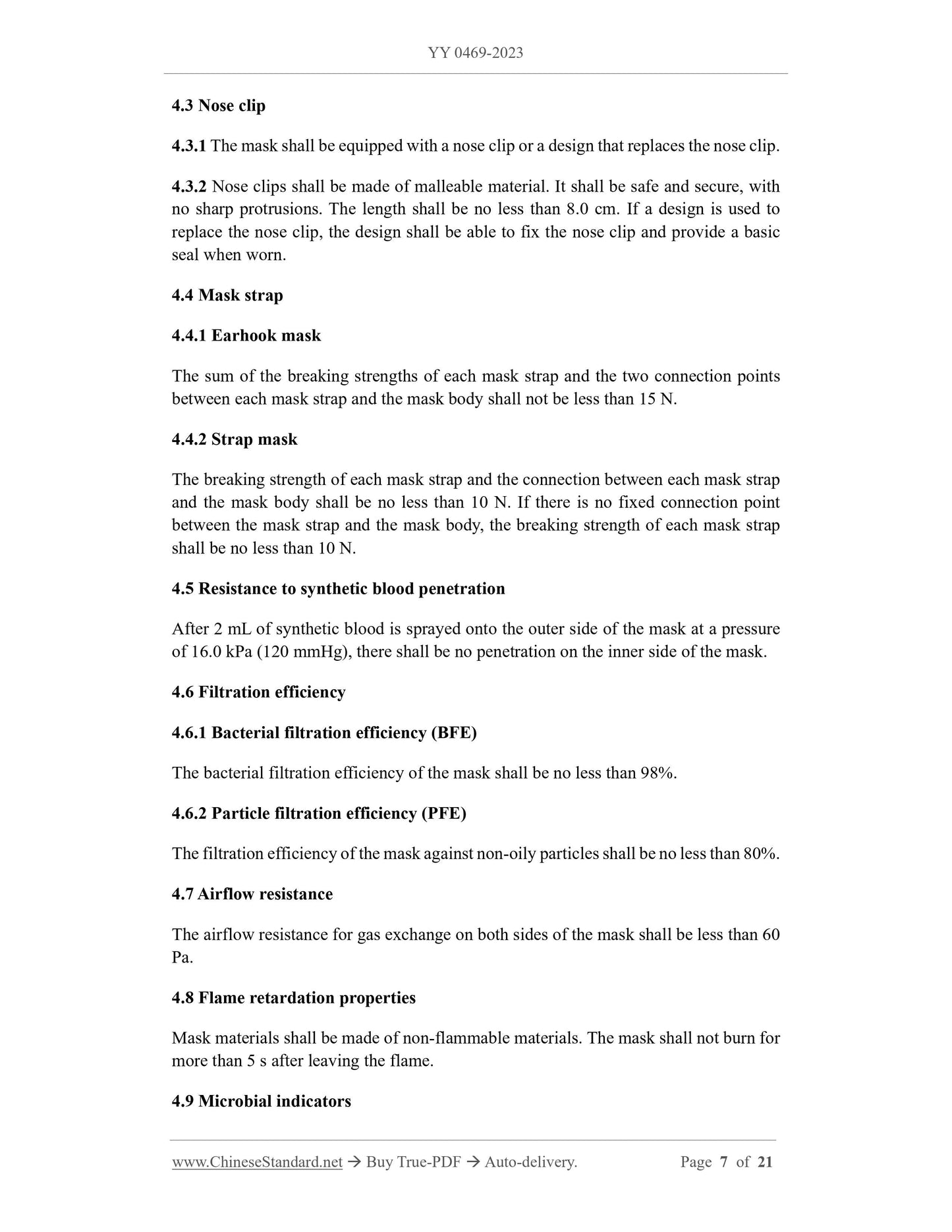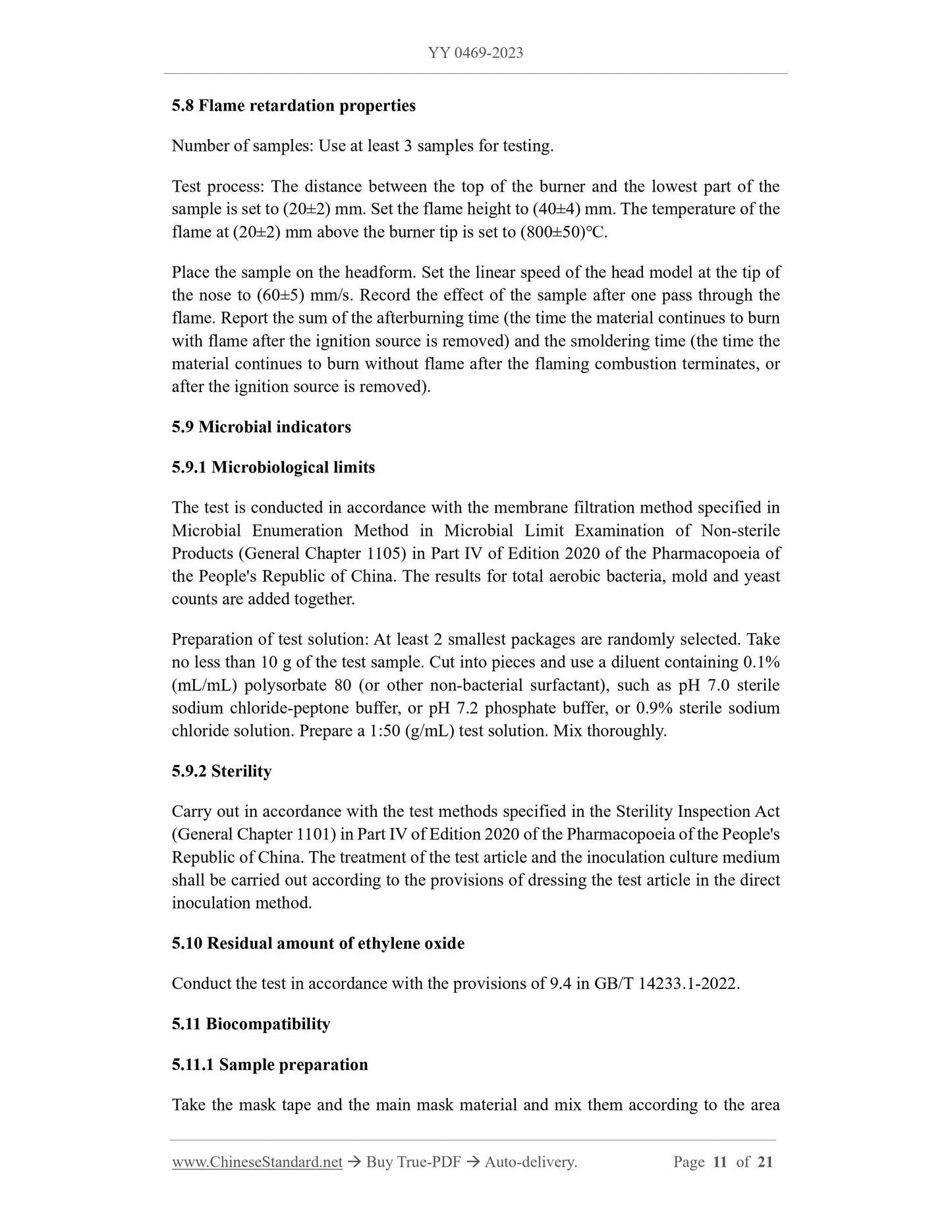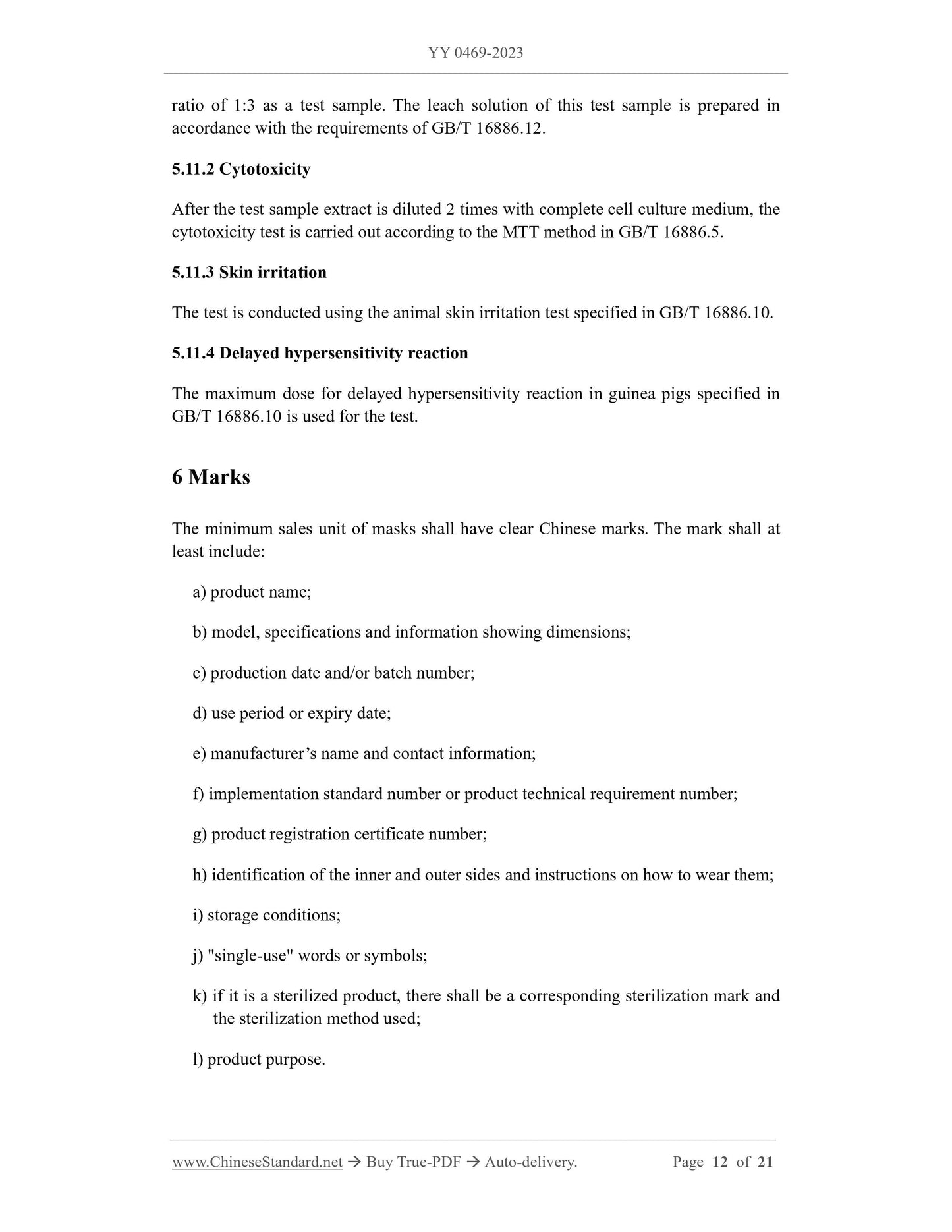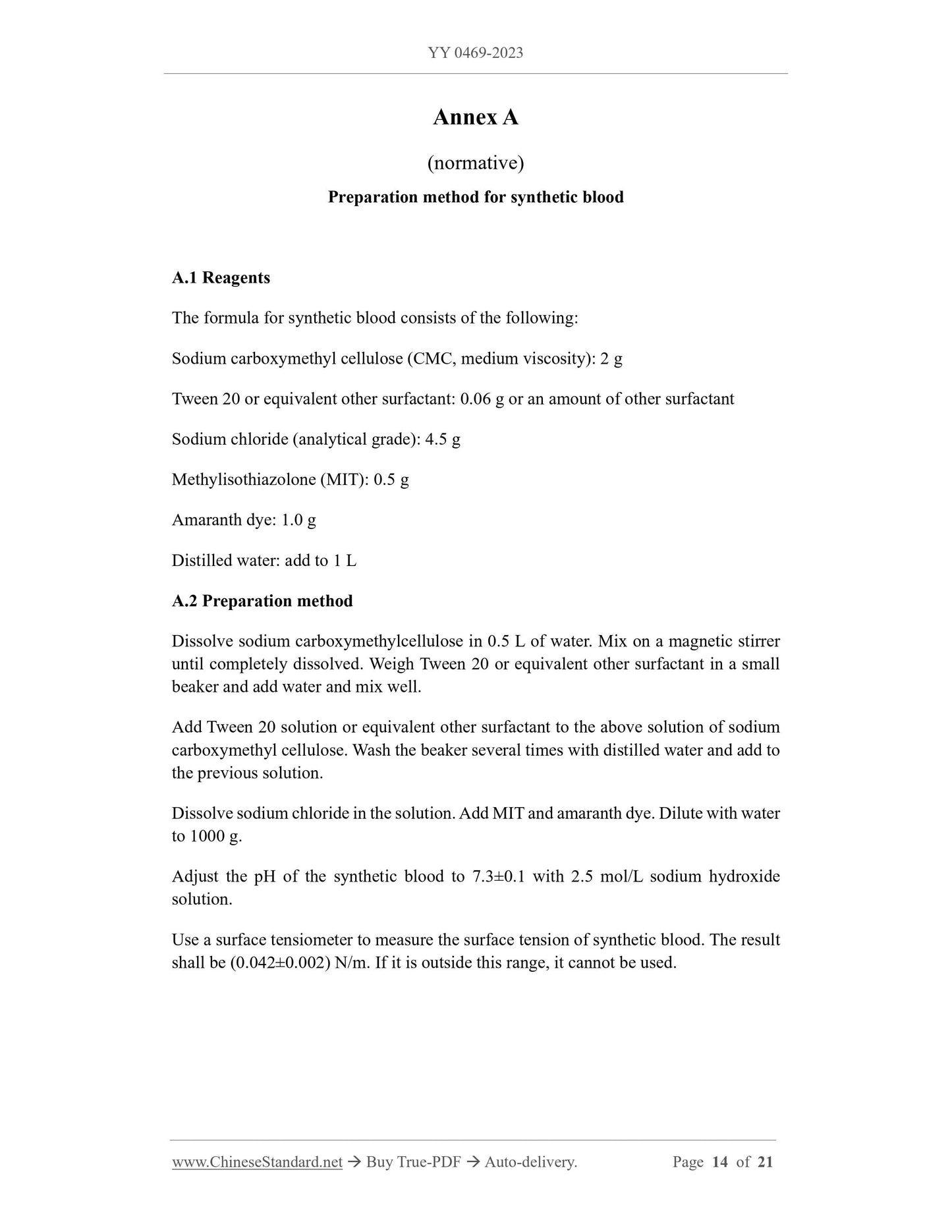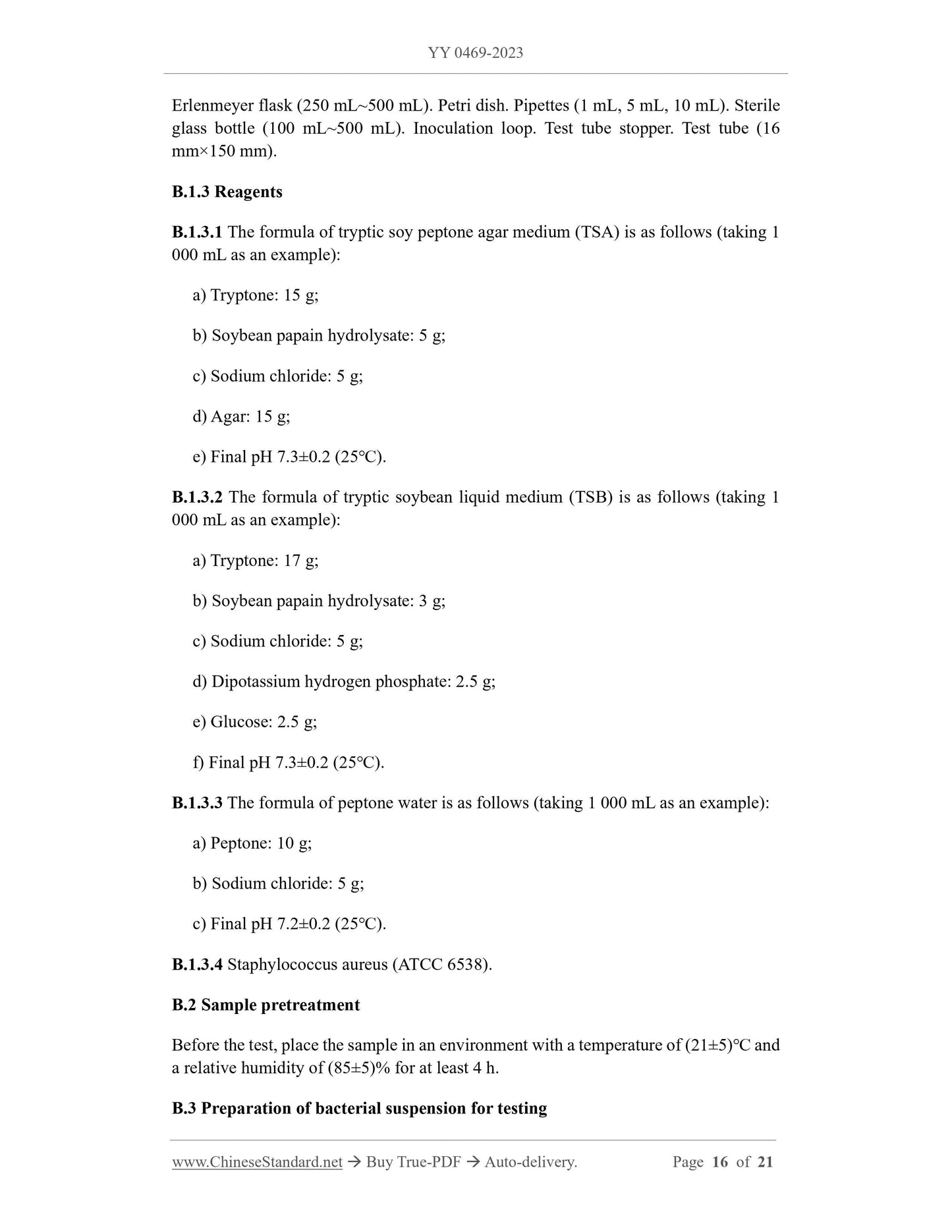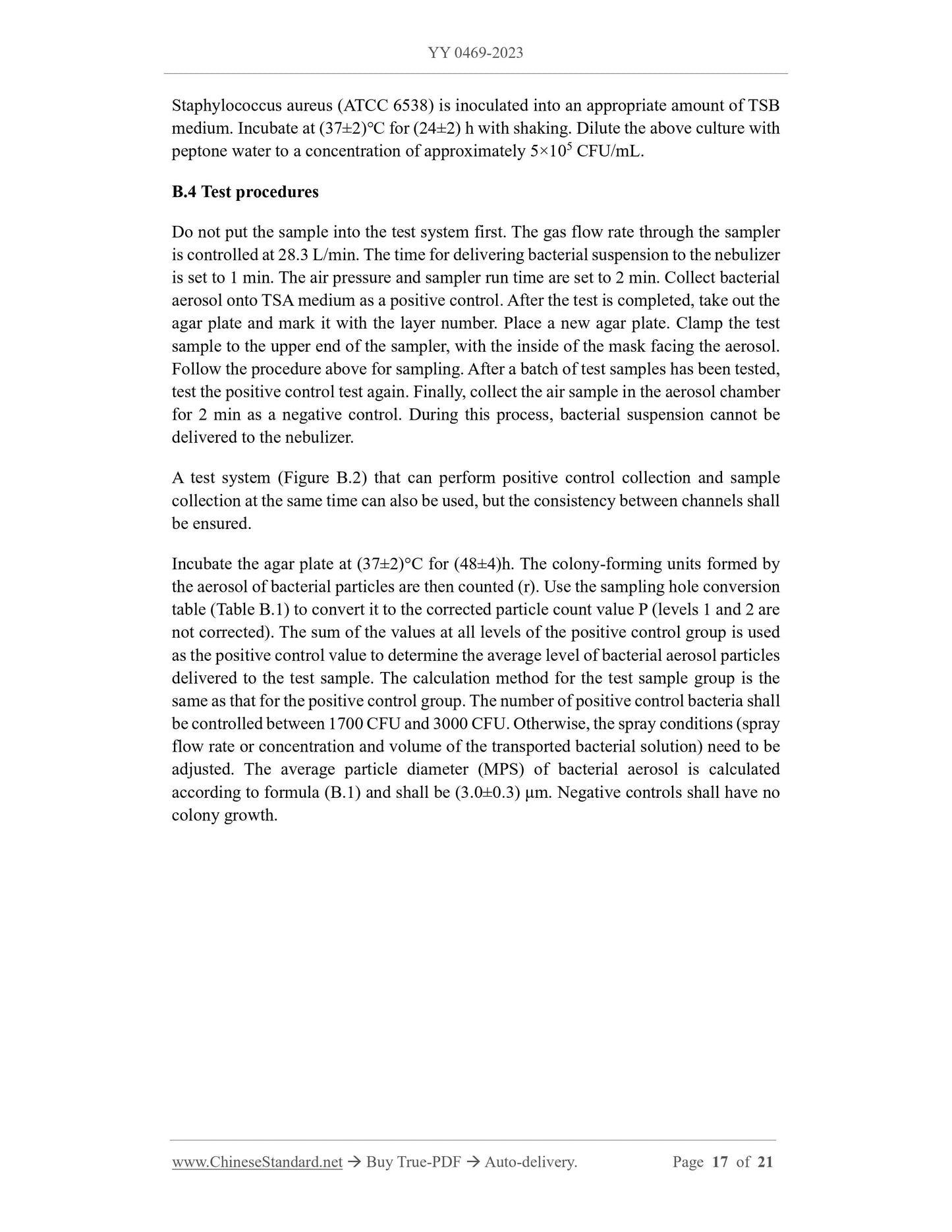1
/
of
10
PayPal, credit cards. Download editable-PDF and invoice in 1 second!
YY 0469-2023 English PDF (YY0469-2023)
YY 0469-2023 English PDF (YY0469-2023)
Regular price
$230.00 USD
Regular price
Sale price
$230.00 USD
Unit price
/
per
Shipping calculated at checkout.
Couldn't load pickup availability
Delivery: 3 seconds. Download true-PDF + Invoice.
Get QUOTATION in 1-minute: Click YY 0469-2023
Historical versions: YY 0469-2023
Preview True-PDF (Reload/Scroll if blank)
YY 0469-2023: Sterile drainage catheters and accessory devices for single use
YY 0469-2023
YY
MEDICAL INDUSTRY STANDARD OF
THE PEOPLE’S REPUBLIC OF CHINA
ICS 11.140
CCS C 48
Replacing YY 0469-2011
Surgical mask
ISSUED ON: NOVEMBER 22, 2023
IMPLEMENTED ON: DECEMBER 01, 2026
Issued by: National Medical Products Administration
Table of Contents
Foreword ... 3
1 Scope ... 5
2 Normative references ... 5
3 Terms and definitions ... 5
4 Technical requirements ... 6
5 Test methods ... 8
6 Marks ... 12
7 Marks, transportation and storage ... 13
Annex A (normative) Preparation method for synthetic blood ... 14
Annex B (normative) Test method for bacterial filtration efficiency (BFE) ... 15
Bibliography ... 21
Surgical mask
1 Scope
This document specifies the technical requirements, test methods, marks, packaging,
transportation and storage for surgical masks.
This document is applicable to disposable medical masks worn by medical staff in
medical environments with potential risks of blood, body fluid, and secretion
contamination and in invasive operating environments.
This document does not apply to protective masks in medical and other working
environments.
2 Normative references
The following referenced documents are indispensable for the application of this
document. For dated references, only the edition cited applies. For undated references,
the latest edition of the referenced document (including any amendments) applies.
GB/T 14233.1-2022, Test methods for infusion, transfusion, injection equipment for
medical use -- Part 1: Chemical analysis methods
GB/T 16886.5, Biological evaluation of medical devices -- Part 5: Tests for in vitro
cytotoxicity
GB/T 16886.10, Biological evaluation of medical devices -- Part 10: Tests for
irritation and skin sensitization
GB/T 16886.12, Biological evaluation of medical devices -- Part 12: Sample
preparation and reference materials
YY/T 0691-2008, Single-use medical face mask
Part IV of Edition 2020 of the Pharmacopoeia of the People's Republic of China
3 Terms and definitions
For the purposes of this document, the following terms and definitions apply.
3.1 surgical mask
A barrier that can cover the wearer's mouth, nose and jaw, and is used to prevent
pathogenic microorganisms and droplets exhaled by the wearer from directly
contaminating the patient or the surrounding environment, and to prevent the patient's
body fluids, blood and other splashes from penetrating the mask and affecting the
wearer. cause some damages.
3.2 synthetic blood
A mixture of red dye, surfactant, thickener, and distilled water whose surface tension
and viscosity can represent blood and other body fluids and have a color similar to
blood.
NOTE: The synthetic blood used in the tests in this document does not have all the characteristics
of blood or body fluids, such as polarity (wetness), coagulability, and cellular material.
3.3 particle filtration efficiency; PFE
Under specified testing conditions, the percentage of particulate matter filtered out by
the mask.
3.4 bacterial filtration efficiency; BFE
Under specified testing conditions, the mask's ability to filter out bacteria-containing
suspended particles.
NOTE: Usually, it is expressed as a percentage.
3.5 flame retardation properties
The ability to prevent itself from being ignited, flaming and smoldering.
3.6 airflow resistance
The resistance of the mask under the specified area and specified flow rate.
NOTE: It is expressed as pressure difference per unit area.
4 Technical requirements
4.1 Appearance
The appearance of the mask shall be neat and in good shape. There shall be no damage
or stains on the surface.
4.2 Structure and dimension
After the mask is worn, it shall cover the wearer's mouth, nose and chin. It shall comply
with the design dimensions and allowable deviations specified by the manufacturer. The
design of the mask shall be able to distinguish the direction of its inner and outer sides.
4.3 Nose clip
4.3.1 The mask shall be equipped with a nose clip or a design that replaces the nose clip.
4.3.2 Nose clips shall be made of malleable material. It shall be safe and secure, with
no sharp protrusions. The length shall be no less than 8.0 cm. If a design is used to
replace the nose clip, the design shall be able to fix the nose clip and provide a basic
seal when worn.
4.4 Mask strap
4.4.1 Earhook mask
The sum of the breaking strengths of each mask strap and the two connection points
between each mask strap and the mask body shall not be less than 15 N.
4.4.2 Strap mask
The breaking strength of each mask strap and the connection between each mask strap
and the mask body shall be no less than 10 N. If there is no fixed connection point
between the mask strap and the mask body, the breaking strength of each mask strap
shall be no less than 10 N.
4.5 Resistance to synthetic blood penetration
After 2 mL of synthetic blood is sprayed onto the outer side of the mask at a pressure
of 16.0 kPa (120 mmHg), there shall be no penetration on the inner side of the mask.
4.6 Filtration efficiency
4.6.1 Bacterial filtration efficiency (BFE)
The bacterial filtration efficiency of the mask shall be no less than 98%.
4.6.2 Particle filtration efficiency (PFE)
The filtration efficiency of the mask against non-oily particles shall be no less than 80%.
4.7 Airflow resistance
The airflow resistance for gas exchange on both sides of the mask shall be less than 60
Pa.
4.8 Flame retardation properties
Mask materials shall be made of non-flammable materials. The mask shall not burn for
more than 5 s after leaving the flame.
4.9 Microbial indicators
5.8 Flame retardation properties
Number of samples: Use at least 3 samples for testing.
Test process: The distance between the top of the burner and the lowest part of the
sample is set to (20±2) mm. Set the flame height to (40±4) mm. The temperature of the
flame at (20±2) mm above the burner tip is set to (800±50)℃.
Place the sample on the headform. Set the linear speed of the head model at the tip of
the nose to (60±5) mm/s. Record the effect of the sample after one pass through the
flame. Report the sum of the afterburning time (the time the material continues to burn
with flame after the ignition source is removed) and the smoldering time (the time the
material continues to burn without flame after the flaming combustion terminates, or
after the ignition source is removed).
5.9 Microbial indicators
5.9.1 Microbiological limits
The test is conducted in accordance with the membrane filtration method specified in
Microbial Enumeration Method in Microbial Limit Examination of Non-sterile
Products (General Chapter 1105) in Part IV of Edition 2020 of the Pharmacopoeia of
the People's Republic of China. The results for total aerobic bacteria, mold and yeast
counts are added together.
Preparation of test solution: At least 2 smallest packages are randomly selected. Take
no less than 10 g of the test sample. Cut into pieces and use a diluent containing 0.1%
(mL/mL) polysorbate 80 (or other non-bacterial surfactant), such as pH 7.0 sterile
sodium chloride-peptone buffer, or pH 7.2 phosphate buffer, or 0.9% sterile sodium
chloride solution. Prepare a 1:50 (g/mL) test solution. Mix thoroughly.
5.9.2 Sterility
Carry out in accordance with the test methods specified in the Sterility Inspection Act
(General Chapter 1101) in Part IV of Edition 2020 of the Pharmacopoeia of the People's
Get QUOTATION in 1-minute: Click YY 0469-2023
Historical versions: YY 0469-2023
Preview True-PDF (Reload/Scroll if blank)
YY 0469-2023: Sterile drainage catheters and accessory devices for single use
YY 0469-2023
YY
MEDICAL INDUSTRY STANDARD OF
THE PEOPLE’S REPUBLIC OF CHINA
ICS 11.140
CCS C 48
Replacing YY 0469-2011
Surgical mask
ISSUED ON: NOVEMBER 22, 2023
IMPLEMENTED ON: DECEMBER 01, 2026
Issued by: National Medical Products Administration
Table of Contents
Foreword ... 3
1 Scope ... 5
2 Normative references ... 5
3 Terms and definitions ... 5
4 Technical requirements ... 6
5 Test methods ... 8
6 Marks ... 12
7 Marks, transportation and storage ... 13
Annex A (normative) Preparation method for synthetic blood ... 14
Annex B (normative) Test method for bacterial filtration efficiency (BFE) ... 15
Bibliography ... 21
Surgical mask
1 Scope
This document specifies the technical requirements, test methods, marks, packaging,
transportation and storage for surgical masks.
This document is applicable to disposable medical masks worn by medical staff in
medical environments with potential risks of blood, body fluid, and secretion
contamination and in invasive operating environments.
This document does not apply to protective masks in medical and other working
environments.
2 Normative references
The following referenced documents are indispensable for the application of this
document. For dated references, only the edition cited applies. For undated references,
the latest edition of the referenced document (including any amendments) applies.
GB/T 14233.1-2022, Test methods for infusion, transfusion, injection equipment for
medical use -- Part 1: Chemical analysis methods
GB/T 16886.5, Biological evaluation of medical devices -- Part 5: Tests for in vitro
cytotoxicity
GB/T 16886.10, Biological evaluation of medical devices -- Part 10: Tests for
irritation and skin sensitization
GB/T 16886.12, Biological evaluation of medical devices -- Part 12: Sample
preparation and reference materials
YY/T 0691-2008, Single-use medical face mask
Part IV of Edition 2020 of the Pharmacopoeia of the People's Republic of China
3 Terms and definitions
For the purposes of this document, the following terms and definitions apply.
3.1 surgical mask
A barrier that can cover the wearer's mouth, nose and jaw, and is used to prevent
pathogenic microorganisms and droplets exhaled by the wearer from directly
contaminating the patient or the surrounding environment, and to prevent the patient's
body fluids, blood and other splashes from penetrating the mask and affecting the
wearer. cause some damages.
3.2 synthetic blood
A mixture of red dye, surfactant, thickener, and distilled water whose surface tension
and viscosity can represent blood and other body fluids and have a color similar to
blood.
NOTE: The synthetic blood used in the tests in this document does not have all the characteristics
of blood or body fluids, such as polarity (wetness), coagulability, and cellular material.
3.3 particle filtration efficiency; PFE
Under specified testing conditions, the percentage of particulate matter filtered out by
the mask.
3.4 bacterial filtration efficiency; BFE
Under specified testing conditions, the mask's ability to filter out bacteria-containing
suspended particles.
NOTE: Usually, it is expressed as a percentage.
3.5 flame retardation properties
The ability to prevent itself from being ignited, flaming and smoldering.
3.6 airflow resistance
The resistance of the mask under the specified area and specified flow rate.
NOTE: It is expressed as pressure difference per unit area.
4 Technical requirements
4.1 Appearance
The appearance of the mask shall be neat and in good shape. There shall be no damage
or stains on the surface.
4.2 Structure and dimension
After the mask is worn, it shall cover the wearer's mouth, nose and chin. It shall comply
with the design dimensions and allowable deviations specified by the manufacturer. The
design of the mask shall be able to distinguish the direction of its inner and outer sides.
4.3 Nose clip
4.3.1 The mask shall be equipped with a nose clip or a design that replaces the nose clip.
4.3.2 Nose clips shall be made of malleable material. It shall be safe and secure, with
no sharp protrusions. The length shall be no less than 8.0 cm. If a design is used to
replace the nose clip, the design shall be able to fix the nose clip and provide a basic
seal when worn.
4.4 Mask strap
4.4.1 Earhook mask
The sum of the breaking strengths of each mask strap and the two connection points
between each mask strap and the mask body shall not be less than 15 N.
4.4.2 Strap mask
The breaking strength of each mask strap and the connection between each mask strap
and the mask body shall be no less than 10 N. If there is no fixed connection point
between the mask strap and the mask body, the breaking strength of each mask strap
shall be no less than 10 N.
4.5 Resistance to synthetic blood penetration
After 2 mL of synthetic blood is sprayed onto the outer side of the mask at a pressure
of 16.0 kPa (120 mmHg), there shall be no penetration on the inner side of the mask.
4.6 Filtration efficiency
4.6.1 Bacterial filtration efficiency (BFE)
The bacterial filtration efficiency of the mask shall be no less than 98%.
4.6.2 Particle filtration efficiency (PFE)
The filtration efficiency of the mask against non-oily particles shall be no less than 80%.
4.7 Airflow resistance
The airflow resistance for gas exchange on both sides of the mask shall be less than 60
Pa.
4.8 Flame retardation properties
Mask materials shall be made of non-flammable materials. The mask shall not burn for
more than 5 s after leaving the flame.
4.9 Microbial indicators
5.8 Flame retardation properties
Number of samples: Use at least 3 samples for testing.
Test process: The distance between the top of the burner and the lowest part of the
sample is set to (20±2) mm. Set the flame height to (40±4) mm. The temperature of the
flame at (20±2) mm above the burner tip is set to (800±50)℃.
Place the sample on the headform. Set the linear speed of the head model at the tip of
the nose to (60±5) mm/s. Record the effect of the sample after one pass through the
flame. Report the sum of the afterburning time (the time the material continues to burn
with flame after the ignition source is removed) and the smoldering time (the time the
material continues to burn without flame after the flaming combustion terminates, or
after the ignition source is removed).
5.9 Microbial indicators
5.9.1 Microbiological limits
The test is conducted in accordance with the membrane filtration method specified in
Microbial Enumeration Method in Microbial Limit Examination of Non-sterile
Products (General Chapter 1105) in Part IV of Edition 2020 of the Pharmacopoeia of
the People's Republic of China. The results for total aerobic bacteria, mold and yeast
counts are added together.
Preparation of test solution: At least 2 smallest packages are randomly selected. Take
no less than 10 g of the test sample. Cut into pieces and use a diluent containing 0.1%
(mL/mL) polysorbate 80 (or other non-bacterial surfactant), such as pH 7.0 sterile
sodium chloride-peptone buffer, or pH 7.2 phosphate buffer, or 0.9% sterile sodium
chloride solution. Prepare a 1:50 (g/mL) test solution. Mix thoroughly.
5.9.2 Sterility
Carry out in accordance with the test methods specified in the Sterility Inspection Act
(General Chapter 1101) in Part IV of Edition 2020 of the Pharmacopoeia of the People's
Share
